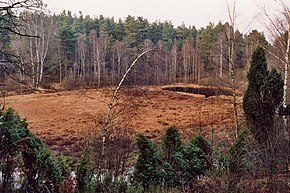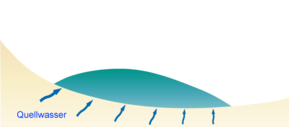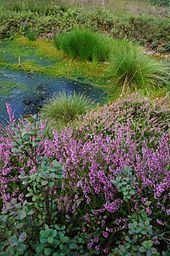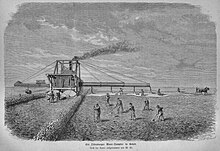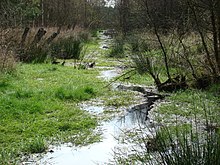moor
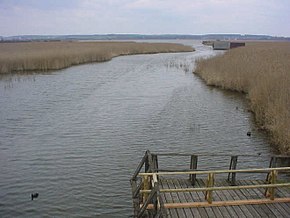

Moors are wetlands , on whose mostly spongy soils peculiar vegetations form characteristic biotopes . Constant excess water from precipitation or from escaping mineral soil water keeps the soil low in oxygen and prevents the complete breakdown of the plant residues, which are instead deposited as peat . This distinguishes them from swamps , which occasionally dry out, which is why their organic matter is completely broken down into humus . Living bogs grow upwards through the growth of peat.
In soil science, bogs are recorded as bog soils or organic soils. In the most coarse subdivision, the moors are divided according to the type of water they supply into raised moors and fens , which in their typical vegetation are also visually clearly demarcated from one another. While raised bogs are characterized by low vegetation, fens also have trees.
distribution
Conditions favorable to peatland growth can be found around the world, especially in North America, Northern Europe, South America, North and Southeast Asia and in the Amazon basin . There, bogs of all kinds and peat deposits emerged with a total area of four million square kilometers, which means they cover 3% of the earth's land area. Parts of Russia, Alaska and Canada are particularly rich in moors. In Germany, moors are found mainly in the northwest, northeast and in the foothills of the Alps. The largest moorland areas worldwide are in the taiga belt of the northern hemisphere.
Formation and development of moors
In order for a bog to develop, the following conditions must be met: The area must be rich in precipitation and have a high level of humidity . A layer of water has to accumulate in the ground, and the production of plant matter has to exceed the losses due to decomposition. After all, the area must not be shaded. In the course of the development of the bog, raised bogs have outgrown the groundwater level of the fens or, in areas with high levels of precipitation, have developed as genuine raised bogs directly on the mineral subsoil. They no longer have contact with the groundwater or the mineral soil and are only nourished by rainwater (“ombrogenic”). Due to the formation of peat, raised bogs grow upwards, hence the term raised bog. A raised bog only grows an average of 1 mm per year. In contrast, fens form in depressions, river valleys, hollows, on slopes at source outlets or through silting up of lake areas. They usually grow only a little in height, but are interspersed with more or less nutrient-rich groundwater, spring water or seepage water up to the surface of the bog (“topogenic”). Their vegetation is species-rich compared to the raised bog and consists mainly of reed grasses, rushes, sour grasses and mosses. Intermediate or transitional moors denote transition stages from low to high moors. While the term transitional moor emphasizes the succession from low to high moor, the term intermediate moor rather describes the vegetation-ecological intermediate position. The vegetation here consists of typical species of both types of bog and can be mixed like a mosaic. The low and transitional bogs in Central Europe are divided into different types of bog according to hydrological and ecological criteria. In Central Europe, moors have been the subject of intensive research for decades and are therefore better known than anywhere else.
Overview of peat types
Since the end of the 17th century, classification systems for peatlands have been developed on the basis of very different characteristics. The work by Grosse-Brauckmann (1962) contains a comprehensive description of the various classification systems . Overbeck (1975) and Wagner & Wagner (2005) provide a brief overview of the classification systems .
Systems of so-called "hydrological bog types" are currently being developed, which are based on the peat formation process or the water regime. This structure started with Post & Gralund (1926). The current classifications of the "hydrological bog types" are based on the first proposals by Succow (1988) and Succow & Joosten (2001).
| Ecological bog types | |||||
| Hydrological peat types | Sauer-Armmoor oligotroph-sour | Sour intermediate bogs mesotrophically sour | Interbase bogs mesotrophic-subneutral | Intermediate limestone bogs containing mesotrophic limestone | Fens eutrophic |
| Spring moors | - | X | X | X | X |
| Slope moors | - | X | X | X | X |
| Swamp moors | X | X | - | - | X |
| Silting bogs | X | X | X | X | X |
| Flood mires | - | - | - | - | X |
| Flow bogs | - | X | X | X | - |
| Boiler Moors | X | X | X | - | - |
| Rain bogs | X | - | - | - | - |
Certain shortcomings of this approach are that in the "hydrological bog type" hydrological, terrain-related and material balance criteria are mixed up:
- Topographical: slope moor, Kesselmoor;
- Mineral regime: spring bog, flood bog, rain bog.
Joosten & Clarke (2002) provide a further development of this peat typology . They have systematized the types of bog based on the parameters mineral regime (origin of the water), water regime (peat formation process) and slope of the surface. The type of overflow bog (surface flow) was incorporated again. Special topographical forms are taken into account on the lower structural levels. The following table is based on the structure according to Joosten & Clarke .
| Water regime (peat formation process) | ||||
| Mineral regime (origin of the water) | Silting bog | Swamp moor | Flow moor | Overflow moor |
| Rainwater bog (ombrogen) | X | X | X | |
| Intermediate / transition bog (ombro-minerogenic) | X | X | X | |
| Fens (minerogenic) | X | X | X | |
| - source moor (lithogenic) | X | X | X | |
| - floodplain (fluviogen) | X | X | X | X |
| - coastal flood moor (thalassogen) | X | X | X | X |
It becomes clear that the hydrological conditions ( water balance ) in particular are decisive for the formation and development ( genesis ) of moors . From the locally different climatic conditions - especially
- the relationship between precipitation and evaporation,
- the duration and depth of penetration of the ground frost ,
- the nutrient content and pH value of the water that nourishes the moor ( ground and surface water )
- as well as the pending mineral soil
there are different types of developmental-hydrological bog . In the landscape, however, two or more types of bog often appear in combination.
Depending on this, different types of ecological bog can still be distinguished. They are differentiated according to the ratio of nitrogen to carbon in the peat (N / C value), the nitrogen content in the bog water and the pH value. The different ecological characteristics of the moors are reflected in the diverse compositions of the flora and fauna .
Developmental-hydrological bog types
Mineral soil water-nourished moors (low and intermediate moors)
Spring moors
Spring bogs are formed when spring water escapes from the subsoil. If the spring discharges are abundant, permanent and even, so that the soil is permanently saturated with water, peat and a spring bog can form. Spring peat is mostly badly decomposed due to the high oxygen content of the spring water and small areas of drying out. They are often muddy due to leaching from the aquifers ( sand , silt , clay ). Depending on the type of terrain , spring moors are either - on flat lower slopes - hillside spring moors - or in valleys - low-rise spring moors. With a high lime content of the spring water, as can be found in areas with adjacent limestone or deposited till , peaks of almost pure lime ( spring tuff or meadow lime) or - with a high iron content - of iron rock silt can form. These peaks can be up to 10 meters high and up to 200 meters wide. In these moors, peat mainly forms on the edge of the hilltops, where the spring water accumulates. They are mostly highly decomposed due to the high lime content. In old moraine landscapes , the soils are mostly deeply decalcified. The spring moors in these regions are rich in bases, but at the same time free of lime. The spring water is also low in lime or lime-free in crystalline low mountain ranges. These spring bogs are usually only very thin.
In the direction of the water runoff, spring bogs often merge into other hydrological bog types, for example flow bogs.
Slope moors
Slope moors are created on flat slopes with damming subsoil, when continuously mineral-rich water from above lying streams and rivulets slowly seeps down on the surface and in the upper soil horizons and the soil remains permanently saturated with water. Because the water builds up before it penetrates the peat, sloping moors grow uphill at the upper end. The peat bodies are usually not very thick, often less than a meter, because as the height increases, the slope becomes so steep that natural drainage begins.
Swamp moors
Moors are formed in shallow depressions with periodic watering on highly compacted or clayey soils or also on sandy soils when the water table has risen. Moors are mainly formed in flat landscapes , for example in floodplains outside the floodplain or in glacial valleys . Therefore, they are usually very large. The thickness of the peat, on the other hand, is usually small (rarely more than a meter thick). Since the groundwater level naturally fluctuates, the peat body is aerated from time to time. Therefore, the peat in swamp bogs is usually badly decomposed and therefore mostly rich in nutrients.
Silting bogs
Silting bogs are created by silting up and overgrowing of still waters (especially lakes ) through the deposition of sediments as muds on the bottom of the water and through the growth of bank vegetation into the water ( swinging lawn ). The peat (Sinktorfe) that forms beneath the swinging lawn sink to the bottom of the water. After silting up, peat growth stops and the peat is usually strongly decomposed on the surface by fluctuations in the water level. Due to the gradual siltation, thick layers of mud can often be found in a silting bog. Alluvial bogs are widespread in Central Europe, especially in the areas covered by glaciers ( young moraine land ) during the last Ice Age ( Vistula or Worm Ice Age ). About 15% of all moors in Germany are silting moors. Their nutrient content depends on that of the silting lake and can therefore fluctuate greatly. However, due to the nutrient inputs by humans, they are mostly eutrophic today.
Flood mires
Flood bogs are divided into the categories of coastal flood bogs (on sea coasts) and floodplain bogs (along rivers). Due to strongly fluctuating water levels, this type of bog is periodically or episodically under water, but can also fall dry when the water level is low. Extensive floodplain bogs arise mainly in very low relief landscapes. A body of peat forms there over a large area but not very thick. The interlocking or alternating layering of peat with mineral material (mostly silt or sand ) which is brought in by the water current when it is flooded is typical for floodplain bogs .
Flow bogs
A flow-through bog is used when the peat body is infiltrated by a noticeable groundwater flow, but this groundwater remains in the bog and does not emerge as a source. They often connect to spring moors, where their water seeps into the peat. Even large areas can develop into bogs, the once existing flowing waters no longer run in an open river bed, but flow through the bog.
Boiler Moors
Basin bogs are particularly widespread in young moraine landscapes (ice disintegration landscapes) or in volcanic landscapes and arise from hollow terrain without natural runoff, for example in dead ice holes ( e.g. Söllen ) or in depressions . Sometimes there is still a residual lake in the middle . Basin bogs are generally small (often less than one hectare ), have no natural inflow and outflow, and are usually very thick with peat .
Precipitation-fed moors (raised moors)
Rain bogs
Rain bogs differ fundamentally from the types of bogs fed from mineral soil water. They arise when certain plants, mostly peat moss, grow so high on low-nutrient groundwater bogs in cold, precipitation-rich climates that the peat they form is no longer nourished by the mineral-rich groundwater, but exclusively by rainwater (ombrogen). They can grow up on the nutrient-poor parts of swamp, silting or boiler bogs. The water level in rain bogs is well above the groundwater level in the surrounding landscape . Because of their bulge, surface water no longer flows in from the area. Rain bogs are secondary or tertiary bog formations. From a hydrological as well as an ecological point of view, they are clearly distinguishable from the low and intermediate moors. The water regime of the rain bogs regulates itself and is self-sustaining because of the special properties of the peat moss that builds up the bogs. Intact rain bogs constantly absorb more water from precipitation than they lose through evaporation and superficial runoff . They resemble peat moss sponges soaked in water lying in the landscape.
Condensation Moors
Condensation bogs are a very peculiar type of bog that is only known from a few locations in the Austrian Alps. The water in the bog here comes neither from the mineral soil nor from precipitation, but from air humidity that condenses on the surface of block heaps under certain conditions . Since condensed humidity is just as poor in nutrients as rainwater, condensation peat bogs are more like raised bogs than fens depending on their vegetation. Typically, condensation bogs consist of a mosaic of the smallest, usually barely square meter sites on a steep slope.
Ecological bog types
The ecological bog types can be distinguished from information on vegetation, nutrient content and the acid-base ratio.
The nutrient content can be divided into three levels: nutrient-poor (oligotrophic), moderately nutrient-poor (mesotrophic) and nutrient-rich (eutrophic). The acid-base ratio is given based on the pH value and, like the nutrient content, is given in three stages. The acidic moors have a pH value below 4.8, weakly acidic moors have a pH value between 4.8 and 6.4 (sub-neutral) and the alkaline moors have a pH value between 6.4 and 8 (calcareous). Consequently, five ecological bog types can be determined with this information: realm bogs (eutrophic), limestone intermediate bogs (mesotrophic-calcareous), base intermediate bogs (mesotrophic-subneutral), Sauer-intermediate bogs (mesotrophic-sour) and the Sauer-Armmoore (oligotrophic) angry).
Raised bogs

Raised bogs are also known as Armmoor or rain bog. They are only fed by rainwater (ombrotrophic) and are therefore acidic and very poor in nutrients (oligotrophic). They only have low levels of nitrogen and other nutrients and are characterized by high carbon levels in peat. The pH values are between 3 and 4.8. The typical flora consists of almost closed peat moss lawns (class: Oxycocco-Sphagnetea ). These nutrient-poor locations can be found over a large area in all rain bogs, small areas in boiler moor centers and very small areas also in the transition areas of rain bogs fed by mineral soil water. Raised bogs often develop on fens but also without prior fens directly on mineral subsoil ( real raised bogs ). Rain bogs can also be clearly distinguished from all other types of bog in terms of ecological conditions. The extreme lack of nutrients, the low pH value and the permanent water saturation of the raised bog habitats result in a highly specialized, unique flora and fauna with a large number of endangered species.
A comprehensive presentation of the ecosystem and the landscape element of the raised bog can be found in the article Rain bog .
Intermediate bogs / transitional bogs
Intermediate or transitional moors are characterized by Kleinseggenriede of the Scheuchzerio-Caricetea nigrae class . In addition to several types of sedges and rushes, other so-called mineral soil water pointers occur in all intermediate and transitional bogs such as the fever clover ( Menyanthes trifoliata ), the swamp blood-eye ( Potentilla palustris ), the pig's ear ( Calla palustris ), the narrow-leaved cotton grass ( Eriophorum angustifolium ), the hound ostrich ( Agrostis canina ), the swamp violet ( Viola palustris ) and the common pennywort ( Hydrocotyle vulgaris ). Peat mosses play a role particularly in the acidic intermediate bogs, whereas the more nutrient-rich forms are characterized by the occurrence of so-called brown mosses.
For the flora of the intermediate moors, see the main article in Kleinseggenried .
Sour intermediate bogs
Acid, moderately nutrient-rich (mesotrophic) moors are very close to the Armmoor, but are fed by acidic mineral soil water and have a slightly better nitrogen supply. Like the Armmoore, they only have pH values up to 4.8. The plant cover consists of small sedge meadows rich in peat moss. These moors can be found in the nutrient-poor and lime-poor areas of the young moraine landscapes, especially in flow-through and boiler moors, in dune areas and in the crystalline areas of the low mountain ranges , there especially in sloping moors. Due to the higher electrolyte content of the soil water, there are significantly more types of sedges to be found in contrast to raised bogs.
Basen-intermediate bogs
Sub-neutral, moderately nutrient-rich peatlands have pH values of 4.8–6.4. They are free of lime. The vegetation of the intermediate bogs consists of small sedge beds rich in brown moss, in which some peat moss still grows. This type of ecological bog can be found mainly in the young moraine area of eastern Central Europe and is particularly endangered today by the general nutrient load. They can occur in silting bogs, hillside bogs, spring bogs and boiler bogs. Their main occurrence, however, is in flow marshes.
Limestone bogs
Limestone to calcareous bog sites with pH values of 6.4–8.5 can be described as rich in minerals, but can be both nutrient-rich and nutrient-poor. The flora consists of small sedge or cutting reeds rich in brown moss. These moors also occur relatively rarely in Central Europe today and have often changed into the very nutrient-rich type of realm moors due to nutrient enrichment. The areas of distribution are lime-rich young moraine landscapes of the Alpine and Tatravo regions , shell limestone areas of the hill country, various low and high mountain ranges with limestone . Mostly they are spring bogs, silting bogs or flow-through bogs. Limestone bog bogs are considered to be very valuable types of bog, which are mostly only formed in small areas and contain numerous relic species.
Fens
Most of the still growing moors in Central Europe belong to these very nutrient-rich locations. The very nutrient-rich conditions, therefore also known as Reichmoor , mostly result from temporary overflow with external water and phase-wise drying out. The growth is mainly determined by the high nitrogen supply, the pH ratios are almost meaningless here and can be between 3.2 and 7.5. Moors rich in nutrients are always nourished by mineral soil water, mainly swamp, spring and flood moors of river plains ( floodplain moors ) and coastal areas. If the conditions are suitable, fens develop into raised bogs via intermediate bog stages. The vegetation consists of mostly dense and tall vegetation stands that largely displace light-loving mosses. The most important vegetation units are alder forests , reed beds and large sedge beds .
The north German fens are usually referred to as fens . In English fens are called fen .
Characterization of the ecological bog types through the vegetation
Many plant species can only survive under certain site conditions. As a result, these are limited to certain moors. The ecological bog types can therefore be characterized very well on the basis of their vegetation composition. The mosses are particularly suitable for this because they are in direct contact with the surface moor water, whether rain or ground water. Higher plants of the nutrient-poor, acidic and purely rainwater-fed raised bogs are adapted to this habitat. Since plants that need more nutrients cannot grow here, they are unrivaled. In fens fed by nutrient-rich groundwater, however, these plants have no chance of survival. So-called mineral soil water pointers settle in transitional areas where the moor is influenced by rainwater and groundwater at the same time . It is not only their ecological behavior that is decisive, but rather the competitive situation in the two opposing types of bog. The border area between pronounced raised bogs and fens is thus indicated by these plant species. This transition area is therefore called an intermediate or transition moor. The development of intermediate or transitional moors is not only spatially, but also temporally between the formation of low and raised bogs, since raised bogs usually begin their development on fenside stadiums.
History of peatland use
peat
Initially, peat was only used as fuel. The resulting ashes were also used in agriculture as fertilizer on the fields. It was also common to use dried peat as a building material for building houses. Around 1880 peat was also used for firing in the iron and steel industry, as litter in stables or as a binding agent. Today it is usually only used in horticulture for soil improvement, in order to aerate the soil and enable a greater water capacity. But since peat lowers the pH value and is more suitable for plants that prefer an acidic environment, the effect on plants in the garden is rather controversial.
As wet landscape elements, moors are difficult locations for agriculture. Nevertheless, attempts have always been made to make use of these locations by partially draining them under difficult conditions.
The draining of the Forum Romanum by the Cloaca Maxima can be seen as one of the oldest uses of the bog - there was previously a swamp in which the dead were buried.
The first systematic peat cultivation was already carried out by Cistercian monks in the early Middle Ages, but came to an end again in the late Middle Ages and as a result of the effects of the Thirty Years' War. With the gradual economic development at the end of the 17th century and increasingly in the 18th century, agricultural activity began again, with extensive fen areas being used. The cultivation of the fens was often done under state funding with extensive and large-scale hydromelioration .
The peat extracted has also been used for healing purposes since the 19th century, for example as a mud bath .
Endangerment of moors
In 1901 Carl Albert Weber wrote: “Unfortunately, it cannot be denied that researchers who deal with the numerous questions posed by raised bogs in particular are already in vain in the north-west German lowlands, one of the most bog-rich countries on earth try to solve them. In a few years this will no longer be possible on German soil at all, given the haste with which one tries to sacrifice the last trace of nature on these interesting formations of usefulness! "
Consequences of drainage
The threat to moors comes primarily from drainage. Almost every use of moors, whether agricultural, forestry, horticultural or peat extraction, is accompanied by a corresponding water regulation. Every form of drainage has an influence on the functions and species composition of the moors. The drainage takes place directly through the construction of ditches, pipe drainage and drainage ditches and the setting of springs or indirectly through river regulation, the withdrawal of drinking water and the associated lowering of the groundwater in the landscape. The effects of the drainage are complex and sometimes only become noticeable in their full extent after many years.
In contrast to mineral soils, peat has an unstable structure due to its almost completely water-filled pore volume. Every dehydration means a reduction in the pore volume, since the pores collapse when they are no longer filled with water. This initially leads to a subsidence of the bog soil , i.e. a decrease in peat thickness. The evaporation of the pore water contributes to the further loss of level. After drainage and aeration, secondary soil formation sets in, which, depending on the time and the trophy of the peat, leads to different structures and speeds at different speeds . In regions with higher rainfall, the soils can become earthy . This creates a dark to black-brown crumb structure in which plant remains are no longer visible to the naked eye, but plant structures can still be seen under the microscope. In drier areas with less precipitation, if the dehydration continues to increase, humic and ash-rich, hard-to-wet and dry fine-grain structures with in some cases cracks and fissures form in the soil. The resulting sludge (dump) is an extremely unfavorable structure because the soil easily erodes and dries out irreversibly. The soils cannot be re-moistened and represent the most extreme bog location. In the less strongly drying subsoil, the mineral soil substance remains moist to wet. The result is a horizon consisting of coal-like caked particles, also known as a murring horizon . The formation of this segregation or secretion structure represents the final stage of the fen soil formation. These soils are difficult to root through and have a very unfavorable water and nutrient balance.
In addition to this physical and chemical damage to the bog, the drainage leads to a reduction in evapotranspiration, which in turn leads to a reduction in cooling in the landscape. In addition, the reduced water saturation of the peat leads to a change in the species composition towards less water-loving species. In general, this leads to a strong reduction in the typical bog biodiversity. In addition, the dewatering increases the risk of fires , which can release large amounts of greenhouse gases and air pollutants that are harmful to the environment and health . Peatlands make up around three percent of the world's land area, but store 30 percent of the earth's carbon - twice as much as all forests combined. Therefore, the rewetting of bogs is an effective way of protecting the climate.
Agricultural use of moors
The agricultural and forestry use of moors works in the conventional way only by lowering the water level. This has the consequence that the hydraulic properties of the peat, such as the water storage capacity and the hydraulic conductivity, decrease. As a result of the drainage, the peat that was previously created in the absence of air comes into contact with oxygen . With persistent aerobic conditions, this process leads to a continuous metabolism of the peat (peat consumption) and thus to irreversible damage to the peat body.
This conventional use inevitably leads to the destruction of the moors and adjacent wetlands. Sustainable use of peatland can only take place at water levels close to the surface, which may lead to peat formation or at least to peat conservation. This alternative is described as paludiculture . The following describes the methods of conventional peatland use.
The bog fire culture is a process in which the surface of the bog was drained and chopped off before winter so that it could be burned down in spring. Buckwheat or oats were then sown in the ashes. The fire was regulated by the direction of the wind and the increasing or decreasing moisture in the ground. With this method, however, the nutrient reserves in the soil were exhausted after 10 years and the land had to lie fallow for 30 years.
In the fenculture, large drainage ditches were dug from which the black peat was extracted. The water channels also served to remove the peat.
The raised bog culture is only used in raised bogs, where the peat is at least 1.3 meters high. The moors are drained, but not pitted, only plowed up and fertilized. The resulting soil is used exclusively for grassland farming.
In the mixed sand culture, sand is lifted up from a depth of about 3 meters and plowed through. The resulting mixed sand culture can be used in many ways in agriculture.
The deep plow sand cover culture is only suitable for fens with a layer of peat not thicker than 80 cm. A deep plow with a working depth of 1.60 m is used to turn the soil by about 135 ° and set it at an angle. In the strongly changing soil profile, peat and sand bars of roughly the same thickness alternate. In addition, the profile is covered by an approximately 20-30 cm thick layer of sand. With this type of amelioration, the soil properties change fundamentally. Due to the strongly increasing water conductivity, the soil water content and the possibilities of groundwater regulation are much more balanced. With the sand deck culture, an intensive grain cultivation on a fen is possible.
In black culture, the peatland is cultivated without any changes after drainage, although this can only be done on fens.
Preservation, protection and regeneration
The preservation of moors does not require major measures. If you leave these habitats to their own devices, this is usually sufficient.
Regeneration of fens
The regeneration of a fen is not as time-consuming as that of a raised bog. Since fens are supplied by the groundwater, simply closing the drainage ditches is sufficient. However, if these are areas that have been used for agriculture for years, they are no longer suitable for renaturation due to the fertilization and extreme tillage. These areas can only be used as a buffer zone against further agricultural use or as a wet meadow, which also offers advantages for the animal world.
Regeneration of raised bogs
The regeneration of a raised bog also initially involves closing the drainage ditches. However, since a raised bog must not be supplied by groundwater, special care must be taken to ensure that the places where the impermeable layer was breached are well sealed. The influence of groundwater would cause the nutrient content to increase too much, which is why artificial irrigation is also ruled out. Pumping the bog water would be conceivable, but this would be a considerable effort.
Renaturation and regeneration
The renaturation of a bog is given as soon as the typical plants, such as the peat moss, settle again. A complete regeneration has occurred when the typical conditions have re-established. This includes the growth and peat formation of a peat moss cover.
In the case of rewetting, there is often a problem with the occurrence of species that colonize arid sites of degraded bogs. At first there seem to be only two options. Either the deposits are extinguished in the event of rewetting or they are retained by not rewetting. In the event of rewetting, the prospects for regeneration (raised bog growth and positive effects on typical raised bog species) of the bog should be considered and weighed against possible negative effects. However, a spatial division can be attempted. There is also the possibility of creating replacement habitats , for example in the Swabian Donauried , where the occurrence of endangered butterflies border on former burning sites and gravel mining areas. Otherwise, it would be possible to dispense with leveling residual peat bodies and instead push back emerging woody plants, which would enable dry heather species to "move". However, the complete removal of trees can have negative consequences for valuable animal species. In addition, near-natural birch and coniferous moor forests rich in dead wood should be taken into account with regard to their importance as refuges for numerous Ice Age and jungle relic species, since under the given conditions there is little prospect of reintroduction.
Regional names for moors
In the German-speaking area there are numerous regional names or synonyms for moors. In common parlance, the terms moor and swamp are mostly used synonymously. In northern Germany the names Bruch, Brook and Luch are common, in southern Germany Ried, Filz (for example Kendlmühlfilzn ) and Moos (for example Donaumoos ). Moss usually refers to a fen, while felt refers to a raised bog. Rülle is the name for the natural runoff of a raised bog within the bog.
Moor fires
In particular, peat bogs that have fallen dry and peat as a combustible material can catch fire . These are mainly smoldering fires below the earth's surface . Since the sources of fire or embers are hardly visible and can be recognized, extinguishing them is extremely time-consuming and difficult.
In June 2018, at least 18 km² of Saddleworth Moor was burned near Manchester in northern England .
In September 2018, the company Airbus Helicopters carried out missile tests on behalf of the German Armed Forces even during the drought in the European summer on the premises of the Defense Technical Service 91 near Meppen . This caused a major fire in which over 12 square kilometers of moorland burned. Over 1500 firefighters and members of the technical relief organization were on duty every day to fight fires.
At the end of May 2020, a moor fire broke out in the Der Loben nature reserve in southern Brandenburg, which quickly spread to around 100 hectares.
See also
- Anmoor , floating moor
- Boardwalk in Emsland , prehistoric boardwalk
- Bourtanger Moor-Bargerveen International Nature Park
- Bog eye
- Moor museum
literature
- Bavarian State Office for the Environment (Hrsg.): A. Wagner, I. Wagner: Guide to fen renaturation in Bavaria . Augsburg 2005, ISBN 3-936385-79-3 .
- G. Colditz: floodplains, moors, wet meadows; Endangerment and protection of wetlands. Birkhäuser Verlag, 1994.
- Karlhans Göttlich: Bog and peat science . 3rd, revised edition. E. Schweizerbart'sche Verlagbuchhandlung (Nägele & Obermiller), Stuttgart 1990, ISBN 3-510-65139-1 .
- G. Grosse-Brauckmann: On the moor structure and address. In: Zeitschr. f. Cultural technique. 3, 1962, pp. 6-29.
- Claus-Peter Hutter (ed.); Alois Kapfer, Peter Poschlod: Swamps and moors - recognizing, determining, protecting biotopes. Weitbrecht Verlag, Stuttgart / Vienna / Bern 1997, ISBN 3-522-72060-1 .
- H. Joosten, D. Clarke: Wise Use of Mires and Peatland . International Mire Conservation Group, NHBS, Totnes 2002, ISBN 951-97744-8-3 .
- Christa Klickermann, Petra Wenzel: Old natural remedy moor - New knowledge for practical application. Klickermann, Laufen 2003, ISBN 3-00-011626-5 .
- Heinrich Mahler: Plants in our moors . Local history writings (plants of the homeland), Wesermünde 1958 ( pdf, 4 MB ).
- F. Overbeck: Botanical-Geological Moorkunde. Wachholtz, Neumünster 1975, ISBN 3-529-06150-6 .
- GM Steiner (ed.): Moors from Siberia to Tierra del Fuego . Biology Center of the Upper Austrian State Museums, Linz 2005, ISBN 3-85474-146-4 .
- Michael Succow , H. Joosten: Landschaftsökologische Moorkunde , 2nd, completely revised edition. E. Schweizerbart'sche Verlag Buchhandlung, Stuttgart 2001, ISBN 3-510-65198-7 .
- M. Succow, L. Jeschke: Moors in the landscape: origin, household, living world, distribution, use and preservation of moors. 2nd Edition. Urania, Leipzig / Jena / Berlin 1990, ISBN 3-87144-954-7 .
- Kai Krüger (Photos: Andre Reiser): Moore: The end of a primeval landscape. In: Geo-Magazin . Hamburg 1978, 8, pp. 74-94. ("Murder on the Moor") ISSN 0342-8311
Film documentaries
- 2015, Jan Haft : Magic of the Moors . Documentation, speaker: Axel Milberg
Web links
- Walter Thut: Moore. In: Historical Lexicon of Switzerland .
- German Society for Moor and Peat Studies
- Moor protection with the Naturschutzbund Deutschland
- Climate hotspot peatland at Scinexx
- Links to moors and wetlands
- The fen as soil of the year 2012
- Scotland's moors are good for the whiskey and the climate. on: badische-zeitung.de , June 20, 2015.
- Characteristics of the moor substrates of the Eberswalde University for Sustainable Development
Individual evidence
- ↑ R. Meier-Uhlherr, C. Schulz, V. Luthardt: Profiles Moor substrates. HNE Eberswalde (Ed.), Berlin 2011, http://www.mire-substrates.com./
- ↑ R. Eggelsmann: rewetting and regeneration of fen . (English title: Rewetting and Regeneration of Fen) In: TELMA. 19, 1989, p. 27.
- ↑ Succow et al.: Landschaftsökologische Moorkunde. 2., completely reworked. Edition. Schweizerbart'sche Verlagbuchhandlung, 2001, ISBN 3-510-65198-7 .
- ↑ C. Berg et al.: Directory of Syntaxa in the volume of tables of the "Plant Societies Mecklenburg-Western Pomerania and their Endangerment". ( MS Word ; 90 kB) 2001: 12.2b Subordination: Lime, marsh sedge and cutting reeds, moderately nutrient-poor, lime-rich depressions and banks.
- ↑ Carl Albert Weber: About the preservation of moors and heaths of northern Germany in their natural state, as well as about the restoration of natural forests . In: Treatises published by the Natural Science Association in Bremen . Volume 15, 1901, pp. 261-279, here p. 268 .
- ↑ Succow et al.: Landschaftsökologische Moorkunde. 2., completely reworked. Edition. Schweizerbart'sche Verlagbuchhandlung, 2001, ISBN 3-510-65198-7 .
- ↑ Gustaf Granath et al .: Mitigating wildfire carbon loss in managed northern peatlands through restoration . In: Scientific Reports . tape 6 , 2016, doi : 10.1038 / srep28498 .
- ^ Moore - incredibly and incredibly important (NDR.de - advice).
- ↑ Sandra Kirchner: Europe's moors are drying up over a large area. In: Klimareporter. November 7, 2019, accessed on November 7, 2019 (German).
- ↑ Martti Mandel: Interview: rewetting of moors to reduce GHG emissions. In: EUKI. November 10, 2019, accessed on November 2, 2019 (German).
- ↑ Wendelin Wichtmann, Sabine Wichmann: Paludiculture: Site- appropriate management of rewetted moors. (English title: Paludikultur - site adapted management of re-weetted peatlands) In: TELMA. Supplement 4, 2011, pp. 215-234.
- ↑ K. Dört among others: Agricultural amelioration . Deutscher Landwirtschaftsverlag, Berlin 1985, ISBN 3-331-00015-9 , p. 286.
- ↑ M. Dolek, M. Bräu, Ch. Stettmer: Wasser marsch ! - And everything will be fine in the bog !? In: ANLiegen Natur. 36 (1), Laufen 2014, pp. 82–89. (PDF 0.7 MB)
- ↑ Laurel Hamers: When bogs burn, the environment takes a hit. July 29, 2019, accessed August 15, 2019 .
- ↑ Julia Merlot: Why the moor fire is so difficult to extinguish in Spiegel Online from September 18, 2018
- ↑ Saddleworth Moor fire is out after more than three weeks. In: BBC News North West. BBC, July 18, 2018, accessed September 20, 2018 .
- ↑ Forest fire in the "Loben" moorland spread over 30 hectares. Retrieved May 29, 2020 .
- ↑ Large-scale deployment of the fire brigades: situation in the event of a major fire in the “Loben” moorland relaxes Nordkurier.de. In: Nordkurier . May 30, 2020, accessed May 30, 2020 .
- ↑ magiedermoore-derfilm.de ( Memento from October 9, 2015 in the Internet Archive ).
